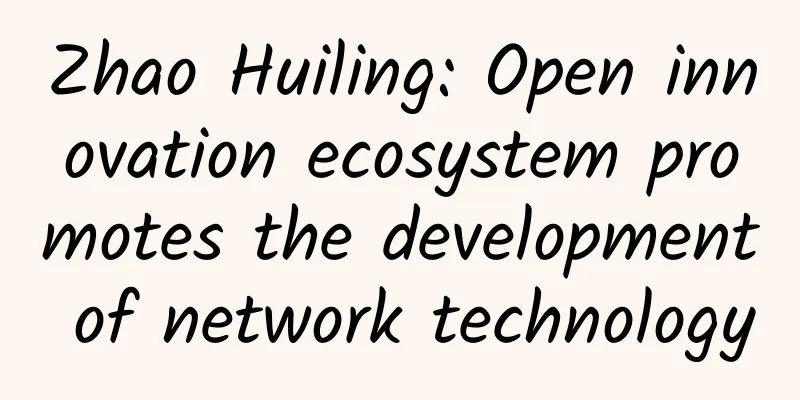Zhao Huiling: Open innovation ecosystem promotes the development of network technology

|
At the theme forum "Future Network Technology Development and Transformation" of the 5th Future Network Development Conference, Zhao Huiling, director of the China Communications Society and chairman of the Information Network Technology Professional Committee, shared with everyone "Open Innovation Ecosystem Promotes Network Technology Development."
We have been discussing the development of the future network and what the network will look like in 2035? Academician Yu Shaohua summarized a TRUST principle (T: Tb/s bandwidth, R: ultra-high reliability, U: ubiquitous connection, S: sub-millisecond latency, T: terahertz spectrum) to look forward to the future. Under the new situation, the overall development of the network includes extreme performance, elastic reconfiguration, multi-resource integration, ubiquitous connection, autonomous management, endogenous security, and green and low-carbon technology features. Under the characteristics of such a large future network, the current development strategy of data development, computing power development and cloud-network integration requires very high computing capabilities. Digital development has brought about an explosive growth in information data, and massive data needs to be stored and aggregated and analyzed in the cloud or edge to realize data value transformation. However, ubiquitous computing power presents characteristics such as multi-level, decentralized, and disordered. It is difficult to achieve unified coordination between computing power and the network, and the intelligent on-demand capability of computing power requires network adaptation. The computing network will become the basic supporting architecture for cloud-network integration. Operators used to only provide connectivity, but now they need to provide computing, storage, and even security capabilities in the network as a service. This is actually an expansion of capabilities and services. The standardization of computing networks has been carried out in an orderly manner in major standard organizations at home and abroad. The research on computing networks is also an important part of the future network field and even the expansion of network capabilities. Now with the development of edge computing, the original form of traditional communication network equipment has changed, and new forms of network equipment have emerged, such as edge Leaf white boxes, fixed-mobile convergence, UPF equipment forms and modularization, which can flexibly customize edge networks, reduce edge deployment costs, and improve programmability. Regarding the protocols in the IP network field, the entire IP protocol can be improved from three dimensions: technical capabilities, security capabilities, and application capabilities. The computing power mentioned earlier is in terms of application capabilities. The development of the Industrial Internet faces challenges such as real-time computing and control requirements on site, complex field interconnection buses, and the need for industrial applications to move towards intelligence. The Industrial Internet needs to achieve low-latency, lightweight, deep integration of information and physics applications on the edge. Finally, AI capabilities are fully infiltrated into the network, realizing ubiquitous intelligence of the network. AI empowers intelligent network operations, which is an important feature of future networks. With the continuous breakthroughs in technologies such as intent-based networks, self-organizing networks, and brain-like computing, a self-learning and self-operating intelligent network is built through all-round and three-dimensional AI enablement. The network digital twin is also very important. Faced with huge pressure from increasingly diverse customer demands and increasingly complex communication network conditions, operators need to change from passive monitoring of network data to active perception of the entire network status. The network digital twin uses data-driven intelligent network status perception to solve the problem of network complexity. In particular, for the complex hierarchical heterogeneous networks in the existing network, a unified data model and resource model are built through digital twins to further realize network simulation, fault prediction and network optimization. The above are some of the more important technical directions and fields in the future development of the network. Zhao Huiling said that the formation, generation and research of standards in the network field require innovation capabilities and are driven by demand applications. Finally, Zhao Huiling also hopes that everyone will work together to promote the development of network technology and promote the development of the entire network with a more open mind. |
<<: The embarrassing 400G: When will the operator backbone network be commercially available?
Recommend
RepriseHosting: 30% off Seattle servers, L5640/16GB/1TB/10TB starting at $27/month
The tribe has shared information about RepriseHos...
TCP/IP protocol is used to transmit onions? This article will give you a deeper understanding
1. Computer Network Architecture Layering Compute...
Ruijie attends the Smart Airport Construction and Development Summit! Giving airports smart wings
From April 17 to 19, the 4th "National Civil...
SD-WAN (Part 2)
The previous article "Things about SD-WAN (P...
HostBrr: $4/month VPS with large hard disk - 2GB memory, 1TB hard disk, 3TB monthly traffic, German data center
HostBrr is a Danish hosting company founded in 20...
HostSlick: Netherlands high-security VPS from 5.99 euros/month, 1Gbps unlimited traffic, optional OpenVZ/KVM architecture
HostSlick is a foreign VPS service provider found...
What are the differences between 802.11ax and 802.11ac Wi-Fi standards? Learn more in one article
In previous articles, we have introduced the orig...
The Future of Wi-Fi: Prepare Your Business for the Internet of Things
Connectivity is critical to nearly every aspect o...
A brief discussion on the 3PC protocol for distributed system consistency
This article is reproduced from the WeChat public...
An article reviews the top 10 wireless network technologies that connect tens of billions of terminals
With the development of the Internet industry, pe...
Maxthon Hosting: VPS in Hong Kong Cera Data Center starts at 40 yuan per month, and Hong Kong CN2 line starts at 60 yuan per month
Maxthon Hosting has long provided 20% discount co...
Why does TCP use three-way handshake? Can't two or four-way handshakes work?
The TCP protocol needs three handshakes to establ...
127.0.0.1 and localhost, how to choose?
In actual development, we often use 127.0.0.1 and...
A "cloud" floats over the grassland: Huawei and the Ulanqab Municipal Government jointly build a cloud data center
Driven by the wave of informatization, Ulanqab Ci...
Huawei releases SD-WAN private line solution to build enterprise wide area interconnection with ultimate experience
At HUAWEI CONNECT 2017, Huawei released the SD-WA...









